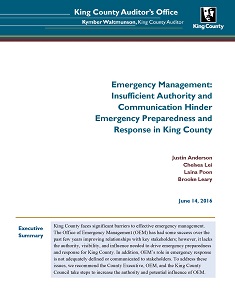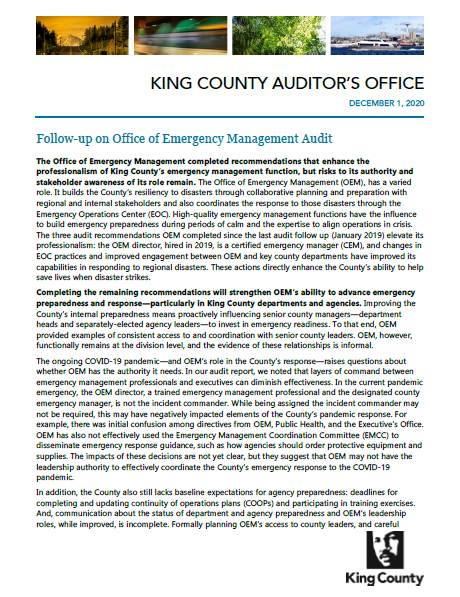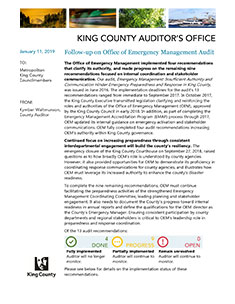Emergency Management: Insufficient authority and communication hinder emergency preparedness and response in King County
June 14, 2016
NEW! Download the latest follow-up report
King County faces significant barriers to effective emergency management. The Office of Emergency Management (OEM) has had some success over the past few years improving relationships with key stakeholders; however, it lacks the authority, visibility, and influence needed to drive emergency preparedness and response for King County. In addition, OEM’s role in emergency response is not adequately defined or communicated to stakeholders. To address these issues, we recommend the County Executive, OEM, and the King County Council take steps to increase the authority and potential influence of OEM.
Status
Of the 13 recommendations:
| DONE | 7 | Recommendations have been fully implemented. Auditor will no longer monitor. |
|---|---|---|
| PROGRESS | 6 | Recommendations are in progress or partially implemented. Auditor will continue to monitor. |
| OPEN | 0 | Recommendations remain unresolved. Auditor will continue to monitor. |
| CLOSED | 0 | Recommendation is no longer applicable. Auditor will no longer monitor. |
Summary
Emergency management plays an important role in the overall preparedness of our region to respond to emergencies and the ability of King County government to continue its essential functions. King County’s Office of Emergency Management (OEM) is tasked with coordinating effective emergency preparedness, response, and recovery for King County government functions and for supporting such functions in the 39 cities and towns within King County.
King County faces significant structural barriers to effective emergency management. The Office of Emergency Management has had some success over the past few years improving relationships with key stakeholders; however, it lacks the authority, visibility, and influence needed to drive emergency preparedness and response for King County. For instance, OEM sits lower in the organizational chart than high-performing emergency management functions in comparable counties. OEM also has no statutory authority to compel county agencies to prepare for emergencies. This impacts the ability of OEM to develop relationships and exercise influence over county and regional actors. For instance, despite OEM working for more than three years to encourage county entities to complete plans that would ensure continuity of essential government functions in an emergency, some offices have yet to complete their plans. In addition, OEM’s role in emergency response is not adequately defined or communicated to stakeholders, further jeopardizing key relationships as OEM delivers promises of support to localities that it may not be able to fulfill.
To ensure effective emergency preparedness, response, and recovery, we recommend that the King County Council and the County Executive take steps to increase the authority and effectiveness of OEM in fulfilling its mission. These include creating specific emergency preparedness-related requirements within King County Code, considering changes to OEM’s organizational placement, and requiring OEM to develop and present an annual report to County Council and the County Executive. We also present several recommendations to improve emergency management processes and outcomes.
Reports related to this audit
Currently, there are no related reports to this project.
Audit team
Justin Anderson, Chelsea Lei, Laina Poon, Brooke Leary conducted this audit. If you have any questions or would like more information, please call the King County Auditor's Office at 206-477-1033 or contact us by email KCAO@kingcounty.gov.

 Translate
Translate


